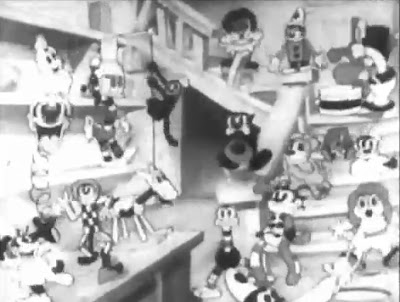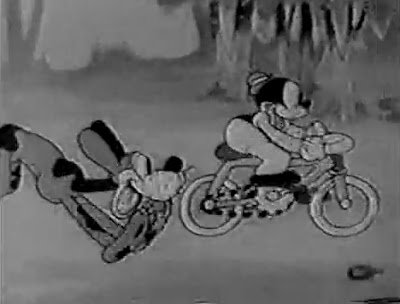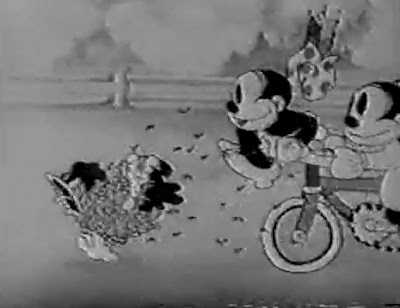Warner cartoon no. 49.
Release date: January 14, 1933.
Series: Looney Tunes.
Directed by: Hugh Harman and Friz Freleng.
Producers: Hugh Harman, Rudolf Ising and Leon Schlesinger.
Starring: Johnny Murray (Bosko).
Animation: Isadore "Friz" Freleng and Thomas McKimson.
Musical Score: Frank Marsales.
Friz Freleng's first film that he got the chance to direct, but only co-direct - so he wasn't fully in charge, like Hugh was. Since I've done 50 reviews, and out of roughly 1001 shorts (951 to review), I've only completed roughly 5% of the challenge. A long way to go.
We then see a dog skating (that looks like Goopy Geer - goodness, he must've been used many times), and the dog is dancing while on his ice skates, with clogs as "ice skates". It's a good visual gag including clogs for ice-skating as it's Dutch shoes. Even a dachshund in skates, but has to where a couple of skates, because of it's length. We even see a duck on skates quacking (wouldn't they have gone south?) and her ducklings are attached to her from a piece of string that has clogs, and each duckling is inside one clog.
We then see a reused gag of a duck that goes inside a windmill, (taking a dump) and then comes back outside back onto the clog. Okay, I really don't see the point of that pathetic gag - yet again, it's a reused gag and Friz Freleng co-directed this cartoon and it sounds like his involvement. The dog continues to dance, as he starts to spin around in his skates and then he spins that fast that his legs suddenly twist and twist, until it's as twisted as it gets. His twisted legs then loosen and go back to normal, and continiues staking.
Bosko continues to skate as a milkman (wearing ice-skates with clogs), and Bruno continues to run with the cart attached to him (wearing clogs too), and as Bruno jumps on top of a log, the cart bumps and a carton of milk falls off, in which a group of "seacats??" come out of a area where the pond shows and they lick the carton of milk.
Bruno continues to skate, until he halts and starts to scratch and we see a dozens and dozens of Dutch fleas coming out (they're wearing clogs too), and Bruno continues to run. It's interesting here on how Harman and Freleng were pretty accurate in which they had to include every character wearing clogs here.
Bosko finishes skating and arrives at a windmill and rings the doorbell. From a long-shot, Honey shouts on the window "Oh Bosko", and Bosko grabs hold of one of the giant fans, and lands on top of the roof with Honey - who is wearing a Dutch bonnet. The pair of them start clog dancing inside the windmill, until Bosko mentions a popular phrase "Ain't we got fun?", and the pair of them sing the song It's Tulip Time in Holland. At least, we see an interesting dance sequence for once - in which it involves clogs.
As the song is being sung, we see outside that there are two small skaters that both look like Wilbur (shall we call it twins?), and they are dancing while skating as well. They skid as they are almost falling onto a pond which isn't frozen. Back to Bosko and Honey, they both continue singing the Holland song, and then there is a shot of a cuckoo clock sleeping and bangs a bowl with his spoon as the time read 4 o'clock. Wilbur and his twin continue to skate happily, but they end up skidding again and trying to run away from the thin ice. They both fall in the pond, and start crying for help.
Bosko and Honey are still singing the song, but are interrupted with the cries of help coming from Wilbur and his twin. They scream help so cautiously, that even the letters "HELP" come out, with a hand pointing at what the trouble is (I've never seen the words come out from Harman-Ising before, but I wonder if Freleng contributed to that). Honey pleads Bosko to "save them".
Bosko then starts to jump onto the clothesline, and lands on a pair of long underwear. He pulls the line, up to where Wilbur and his brother are drowning on the icy water. Bosko's head pops out at the rear patch, with his hands coming out of the sleeves to rescue Wilbur and his brother - a very clever part (clothing). Honey then pulls the clothesline towards Bosko, but suddenly even more trouble happens as the pair of long underwear suddenly rips and causing Bosko to fall down on thin ice, in which Wilbur and his brother are stuck on a piece of ice screaming for "HELP".
The Wilburs end up being stranded on a frozen river, and Bosko is at shore running to catch them up hoping to find a plan to get those two back safely. He does find one as he climbs down a ladder at the edge of a bridge, and instead the Wilburs go through a pipe - which is EVEN MORE problematic. Bosko quickly discovers a water pump, and starts pumping until Wilbur and his twin come out of the spout in which they reunite with Bosko and Honey happily - and that's all folks.
Well, as this was Freleng's first time he got to do some directing, but not in charge of production; and I notice some interesting parts in that cartoon that probably was one of Friz's contributions. The fact that this cartoon was quite analytical and accurate with having all the characters with clogs on, and that the settings really do look Dutch - I wonder if Hugh and Friz did some research? The word "HELP" coming out reminded me of something that wasn't by Hugh Harman or Rudy Ising - unless a gag person like Bob Clampett or Earl Duvall was involved with that? I didn't mind this cartoon at all, but it wasn't very special, even at Friz's first attempt - it shows how a later-great director like him wasn't great at the first attempt (well, he only co-directed), not really in control of the cartoons.



















































